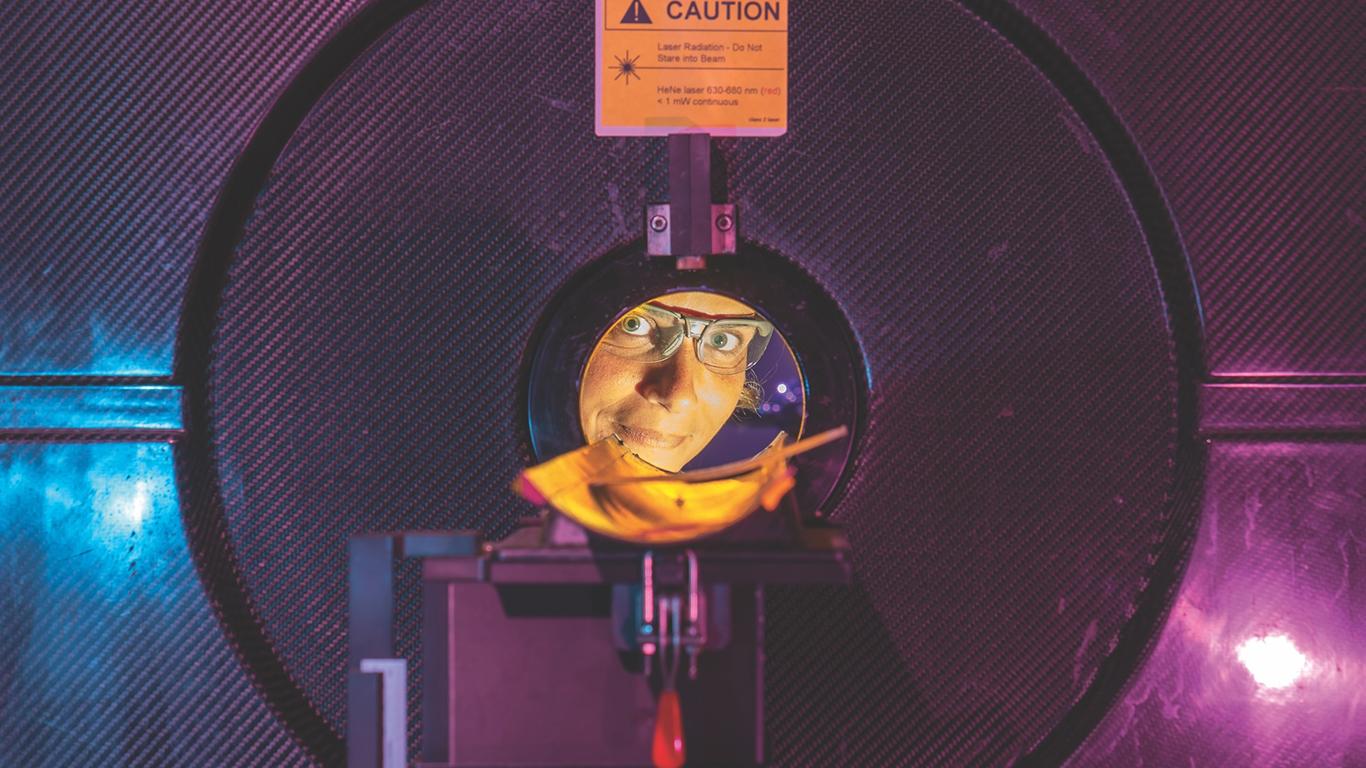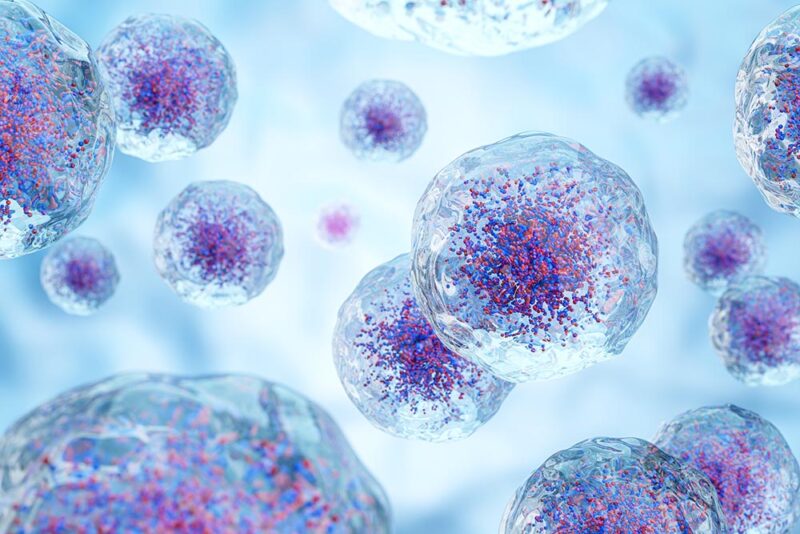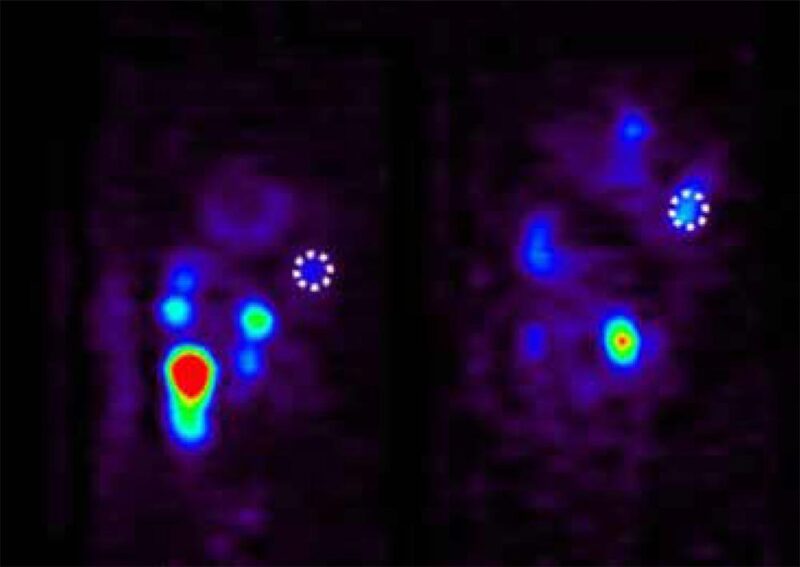In Sickness and in Health

The promise of nuclear medicine
The dawn of the nuclear age nearly 80 years ago heralded a new era in energy — as well as in medicine. Today, radioactive metals have become an integral part of modern life, but they can be a double-edged sword when it comes to human health. At their worst, they are deadly, but when radioactive metals can be precisely controlled, their unique properties can be harnessed to deliver life-sustaining medical treatments.
Rebecca Abergel’s research bridges these extremes. A decade ago, the associate professor of nuclear engineering and of chemistry developed an anti-nuclear contamination pill that can remove radioactive metals like uranium and plutonium from the body, potentially saving thousands of lives in the event of a nuclear incident. Now, she is working on other novel applications, like delivering highly potent alpha radiation directly to cancer cells and removing other heavy metal contaminants from the body.
Abergel’s research centers on lanthanides and actinides — the two rows of heavy metals at the very bottom of the periodic table. Set aside from the table’s otherwise neat rows and columns, many of these elements have familiar names like berkelium and californium. But because they are rare and are often unstable, the properties of lanthanides and actinides are much less familiar than those of other elements.
By deepening our understanding of the fundamental properties of these unusual elements and leveraging these properties with synthetic molecules, Abergel is building on the Berkeley legacy in this arena. The molecules she synthesizes bond to heavy metals through a chemical process called chelation, affording her a degree of control that can enable the removal of harmful metals from the body, while delivering helpful ones to the places they are needed the most.

Cancer research has been a key interest for Abergel, as she works to advance promising therapeutic options. The first known attempts to treat cancer date back to ancient Egypt, where a medical text described how to surgically remove a breast cancer tumor.
The text also noted that the disease had no cure, and thousands of years later, that’s still the case. But one day soon, Abergel hopes that could change.
Targeted alpha-particle therapy (TAT) is an emerging treatment that can deliver powerful doses of radiation directly to cancer cells while causing minimal damage to surrounding tissue. In clinical trials, the approach has shown promise for the treatment of metastatic prostate cancer, and now, Abergel is exploring how it could be used to treat other forms of the disease.
“TAT could be a very versatile, universal type of therapy. It could treat almost any type of cancer, but we don’t have all the tools we need to do that yet,” she says.
Abergel compares TAT to attacking a tumor with a tiny nuclear missile. Her work in this field centers on the molecular scaffold that bonds to a radioactive element, transporting it to the site of the cancer. There, a protein bonded to the molecular scaffold attaches to the cancer cells, bombarding them with radiation from alpha particles.
Alpha particles are produced by the radioactive decay of some heavy elements. They consist of two protons and two neutrons — the same composition as the nucleus of a helium atom. Because alpha particles are large and heavy, they can’t go very far from their source. In biological tissue, they travel about a tenth of a centimeter, which maximizes the impact of the radiation in the immediate area of a tumor, while minimizing damage to everything else. But for this type of treatment to work, you need to deliver radioactive material to the site of the cancer and keep it there. That’s easier said than done.
“It is not a new concept — diagnosing and treating cancer with radiation is what nuclear medicine is all about,” says Abergel. “But alpha particles are the most energetic type of ionizing radiation, so they can deposit a lot of energy very locally and do a lot of damage to cancer cells. It could enable treatments that are less toxic to patients, but if you can’t target the radioactivity precisely, you could damage healthy tissues and induce secondary cancers.”
“If we could produce as much of an isotope as we wanted and solve the challenge of reliably attaching it to a protein, we could treat pretty much anything.”
TAT has three main steps. First, you need to create the radioactive isotope. Then, you need to identify a material that can bond to it and transport it to the site of a tumor — the molecular scaffold. Finally, you need a peptide or a protein that can bond to the molecular scaffold and attach itself to cancer cells once it reaches them.
Actinium, one of the metals used in TAT, is a soft, heavy metal that was first identified in 1902 by Friedrich Oskar Giesel, working with the residues of an experiment conducted by Marie and Pierre Curie. The metal is unstable and highly radioactive.
Some of its isotopes have a half-life of only a few hours; because it decays so quickly, actinium is almost never found in nature. The material used clinically, actinium-225, can only be synthesized at a few specialized facilities, one of which is Berkeley Lab’s 88-inch cyclotron, a type of particle accelerator that can induce nuclear reactions to produce new isotopes. Chemical manipulations are then needed to separate the metallic products of radioactive decay from the elements that produced them.
Actinium-227, the isotope of actinium that Abergel uses in her research, is derived from uranium-233, a radioactive isotope first identified at Berkeley in 1940. At Berkeley Lab’s Heavy Element Research Facilities, small amounts of the metal can be obtained from decaying uranium-233 in a process that Abergel compares to milking a cow. It is only possible to extract tiny amounts of actinium, but luckily, only vanishingly small amounts are needed to conduct the research, which is still in the pre-clinical stage. There are just 5 micrograms of the stuff available for these experiments — an amount so miniscule you’d need an electron microscope to even see it.
Abergel has created a scaffold that bonds to actinium. It starts with a synthetically produced molecule called a ligand. It is composed of carbon, oxygen and nitrogen atoms, and is large enough to fully surround the actinium. The ligand has free electrons that form chelating bonds with the positively charged actinium. The resulting small molecule is held together tightly.

The molecular scaffold needs to have a high affinity for the metal — it has to want to form a chelating bond with it. Inside the body, many naturally-occurring metals are present, including calcium, iron and zinc. So, the scaffold needs to maintain its bond with the actinium, even when other metals are available to bond with.
“A chelator is a little like a claw machine that clamps on to the radioactive material in a chemical reaction,” she says. “The hurdle is to design a molecule that has enough coordinating atoms that can arrange in space in a way that will fully surround the metal ion and get it to stay there.”
The metals already in the body are present in far greater amounts than the actinium, and the molecular scaffold can’t release the actinium and bond with, say, iron instead. It needs to stay bonded to the actinium until it reaches the cancer cells, then attach to them. Identifying which molecules will work together is a process that leans on a chemist’s intuition.
“When you work with a certain section of elements on the periodic table long enough, you get a feel for what shapes of molecules might interact with that system,” says Trevor Arino, a Ph.D. student in Abergel’s lab. “You get a feel for which elements could be good electron donors and would form the ideal kind of bond with the molecules you’re working with.
To deliver the molecular scaffolds to the site of a tumor, Abergel’s group has partnered with researchers at the Fred Hutchinson Cancer Center in Seattle, who have developed a protein that will attach to blood cancer cells. The protein’s amino acids carry a positive charge, which leads to an electrostatic interaction with the negatively charged molecular scaffold, causing them to bond into a larger molecule that will attach to cancer cells. Incidentally, this molecule was also shown to slowly crystallize over the course of about a week, which led to the first ever single crystal structure known to incorporate actinium.

The protein, ligand and a purified version of actinium are combined in a solution to form a single large molecule that serves as a vessel to transport the material through the bloodstream. That step — like all the others — must be executed seamlessly to ensure the treatment is safe and effective. But the potential for this type of therapy extends far beyond blood cancer.
“If we could produce as much of an isotope as we wanted and solve the challenge of reliably attaching it to a protein, we could treat pretty much anything,” says Abergel. “We could target any cancer, because cancer cells have no real protection against internal contamination with radioactivity. If all the parts come together, and we learn to target these therapies precisely, we can adapt them to whatever we hope to accomplish.”
In France, Marie Curie is a national hero. Curie’s ground-breaking research with radioactive metals earned her a Nobel Prize in 1903 — the first time the award was given to a woman. And when Abergel was growing up in Paris, Curie was more than just an intellectual giant, she was a role model.
In the 1990s, there were fewer women scientists than there are today, but Curie’s accomplishments were proof of the possibilities. As an undergraduate student, Abergel began following in Curie’s footsteps. She found herself drawn to the complicated chemistry of heavy metals, elements so rare that understanding their fundamental properties has been challenging. Moreover, slightly different isotopes can exhibit wildly diverging properties.
“I like that heavy metals are challenging to work with and to understand,” she says. “The chemistry is tuned to each individual element, and there are properties you just don’t see anywhere else.”

Today, Abergel leads the Heavy Element Chemistry Group at Berkeley Lab, where she seeks to understand the radiological and chemical behavior of heavy elements in biological systems. Back in 2014, Abergel developed an anti-radiation pill that uses a chelating molecule to remove radioactive materials from the body, and that molecule continues to play a role in her research today.
“If a nuclear attack ever occurred, it would immediately cause some acute radiation poisoning, but the longer-term concern is radioactive contamination of water and soils,” says Abergel. “This can increase the incidence of cancers, killing thousands more. People will ingest or inhale the radionuclides dispersed after a blast. Plutonium or uranium can deposit in the skeleton or organs like the liver and the kidneys, but this pill allows us to target them and remove them, reducing the risk of developing those cancers.”
But the chelating molecule in that pill will bond to any lanthanide or actinide metal, not only plutonium or uranium. That could enable a wide range of applications unrelated to nuclear accidents. One of them is removing gadolinium from the body.
Gadolinium is a contrast agent used in about one-third of patients undergoing magnetic resonance imaging (MRI) scans. It enhances the quality of the signal and is used to image tumors and blood flow. But gadolinium-based contrast agents can have side effects like brain fog and joint pain. They can even cause life-threatening kidney complications.

The chelating molecule used in Abergel’s anti-radiation pill can bond to gadolinium and remove it from the body once a scan has been completed. To accomplish this, Abergel needed to recalibrate the dosing regimen — the duration and frequency of treatment. The first heavy metal-removing version of the pill is currently in phase 1 clinical trials, which assess safety for human consumption. There could be even more applications for that same chelating product. Because it will bond with any lanthanide or actinide metal, it could potentially be used to treat people exposed to fumes at mine sites for rare earth metals, which are lanthanides. And in 2018, Abergel published data indicating it could also be effective at removing lead or cadmium from the body.
The potential applications for these metals and the chelators that bond to them are wide-ranging, and we are still learning about all they can do. But Abergel hopes her research is filling in the gaps in our knowledge and unlocking innovative applications that leverage the unique properties of these metals.
“The search for heavy elements and the search to understand their behavior is a legacy of Berkeley,” she says. “We have a long-standing program dating back to the Manhattan Project. I couldn’t do this work anywhere else.”
